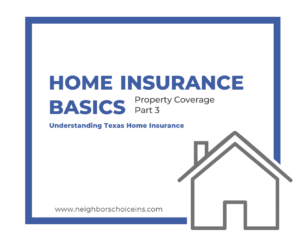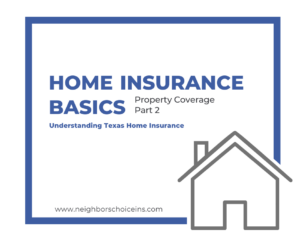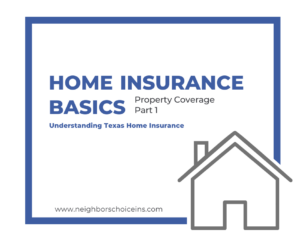Two more big concepts in home insurance are deductibles and loss settlement options. These two factors can make a big impact on the premium paid for insurance and an even bigger financial impact in the event of a claim. We’ll start our discussion with the concept of deductibles.
Deductibles
A Deductible is a specific amount of money that the insured must pay before an insurance company will pay a claim or the amount the insured is responsible to pay before the insurance company starts to pay. Sometimes shown as a specific dollar amount and other times shown as a percent of the total insurance limit.
On the home insurance policy, there are two main deductibles. The first is the Wind/Hail Deductible and the other is the All Other Perils (AOP) Deductible. Sometimes these two deductibles are the same, but many times they are different. The deductibles are applied to the perils described – for example, any covered loss that is caused by the perils of Wind or Hail are subject to the Wind/Hail Deductible. For any other covered loss, the All Other Perils Deductible applies.
In the past, in Texas, the Wind/Hail Deductible could be as low as $500. With the incredible amount of claims to repair and replace hail damaged roofs – specifically in the DFW area – most insurance companies have made the choice to increase the minimum deductible for Wind/Hail. Some companies offer a minimum 1% deductible for Wind/Hail while others offer a minimum deductible of 2% for Wind/Hail.
Deductibles that are expressed as a percentage are calculated based on the Dwelling (Coverage A) limit. For example, a $500,000 Dwelling amount – if the Wind/Hail Deductible were listed as 1%, the Wind/Hail Deductible would be $5,000. If the Wind/Hail Deductible were listed as 2%, the Wind/Hail Deductible would be $10,000.
Sometimes there are other deductibles applicable to separate coverages or causes of loss. Those specific deductibles would be shown in the Declarations next to the coverage for which they apply.
It makes sense that the insurance company would expect the insured to take some part in the financial responsibility for any loss that occurs to the insured property. In general, the higher the deductible, the lower the premium and vice versa. Deductibles help control insurance costs – both for the insurance company in regards to claims, but also the policyholders in regards to premium.
Loss Settlement Options
Loss Settlement is the amount an insurance company pays out in the event of an insurance claim. When it comes to home insurance coverage, the two most common loss settlement options an insurance company offers are: Replacement Cost or Actual Cash Value.
Replacement cost refers to the amount it takes to repair or replace the property with like kind a quality at today’s prices. Actual cash value refers to an amount where the cost of depreciation has been removed from the amount that will be paid.
Depreciation is a reduction in value of an item due to the passage of time – “wear and tear”. A good example of depreciation is with clothing. When you go to the store and buy a new piece of clothing, you pay the retail price that the store charges. After you wear the article of clothing a few times, the value of the article of clothing decreases. If you were to try and sell that article of clothing, say a year later, you would likely get much less than what you paid for it new. The difference between the cost you paid new and the amount you would get if you sold it a year (or however long) later is the depreciation. In general, the older the item gets, the less it is worth.
When comparing replacement cost and actual cash value, you can see that replacement cost would most likely yield a higher payout for any particular piece of property.
In car insurance, the coverages comprehensive and collision include both a specified deductible (often times $500) and a loss settlement method (almost always actual cash value). Have you heard the saying that once you drive a new car off the lot, it losses a certain % of its value? That loss in value is another example of depreciation.
In the case of homeowners insurance, it is wise to choose a policy that includes replacement cost for the dwelling and personal property. In fact, if you have a mortgage on your home, the mortgage company will likely require your home be insured for replacement cost. The mortgage company wants to make sure that in case of a total loss, they will be able to recover their investment in the property.
Some notes about replacement cost. In the event of a property claim in which the settlement method is replacement cost, the insurance company usually issues a preliminary check based on the actual cash value of the damaged property. The insured then purchases or repairs the damaged property and submits receipts back to the insurance company showing the actual cost of repairs and/or replacement of the property. At that time, the insurance company adjuster reviews the differences in actual cash value versus the cost to replace and issues an additional payment to the insured known as recoverable depreciation.
Once the policy limit is reached, there is no longer an obligation for the insurance company to issue any more payments for damaged or destroyed property. Just because an insurance policy says that it is replacement cost does not mean there is actually enough coverage to replace everything in the event of a total loss. This is why it is important to take and keep an updated inventory of your belongings at all times. While the policy limit chosen may seem like enough, when it comes to the time of a claim, policy limits can be exhausted quite quickly. All the small things can really add up.
Another reason to keep an inventory of your belongings is that in the event of a loss, your records will help the insurance company settle the claim in a timely manner. You must be able to prove you had the belongings you claim to have had. Receipts and pictures are the most helpful when it comes to processing a claim.
Conclusion
Deductibles and loss settlement options play a big role in homeowners insurance. Skimping out to save some premium may end up costing much more in the event of a claim. Insurance is all about managing risks and part of managing risk is determining how much financial responsibility you want to have in the case of a loss. When you work with a local independent insurance agency like Neighbor’s Choice Insurance Agency, you can find the balance of premium (cost) and coverage that helps you feel more confident about the risks of the future.
Disclaimer: This blog is for general informational purposes only. Please remember, for specific information about your coverage and your policy, please read your insurance policy. If there is any conflict between the information in this article and the actual terms and conditions of your policy, the terms and conditions of your policy will apply.
Contact Us!
At Neighbor’s Choice Insurance Agency, we can work with you to make sure you’ve got the insurance coverage you need, while at the same time using all possible credits and discounts to make that coverage affordable. Just give us a call at 817-421-8866 or send us a note at info@neighborschoiceins.com. We want to help you meet your goals, and make sure what’s important to you is protected!






